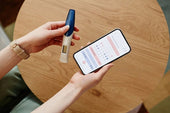How to Calculate Ovulation with Clomid Calculator?

Ovulation is the time during the female menstrual cycle when the ovaries release an egg. The chances of conception for a female are maximum if she plans intercourse in these days [1]. This highlights the importance of ovulation for couples planning to conceive.
There are several effective methods to determine ovulation days, including a clomid calculator. Clomid or clomiphene citrate is a chemical that women take to induce ovulation [2]. This chemical triggers ovulation by causing hormonal changes in the body.
In this article, we’ll explore the importance of ovulation calculation, how a Clomid ovulation calculator works, how accurate it is, and some other methods to calculate ovulation.
Why Is Calculating Ovulation Important?
Ovulation is the process when the ovary releases an egg, which is ready for fertilization. This happens once during each menstrual cycle, usually about 14 days from the start of the cycle [1].
Studies show that a female egg can only survive for 12 to 24 hours, meaning that the timing of intercourse is key for successful conception [3]. If a woman knows what her ovulation date is, she can plan intercourse a few days before ovulation or on the ovulation day, a duration called the fertile window. This will make it possible for a sperm to reach the egg when both are ready for fertilization.
If you are taking Clomid to stimulate ovulation, it is essential that you keep track of ovulation to ensure that the medication is working as intended. It also helps identify the most fertile days to increase the chances of conception.

What Is a Clomid Ovulation Calculator?
A Clomid ovulation calculator is a tool designed to predict when ovulation is likely to occur after taking Clomid. Clomid is a medication that many women use when experiencing challenges in conception because of irregular ovulation [4].
This medication works by stimulating the ovaries to release eggs. The Clomid calculator typically asks for the first day of your last period and the days you took Clomid to determine your ovulation days.
Suppose the first day of your last period was December 2, and you took Clomid from December 5 to December 9 (cycle days 3 to 7). Based on this information, a Clomid ovulation calculator would estimate your ovulation to occur between December 14 and December 19, which is 5 to 10 days after taking your last Clomid pill.
How Accurate Is a Clomid Ovulation Calculator?
Like any other ovulation method, the Clomid calculator is not 100% accurate. However, it can provide you with valuable insights about your ovulation days. Many factors can influence the timing of ovulation, like individual cycle length and body response to Clomid.
The best practice is to use this calculator as a general guide. If you want to determine your ovulation days with maximum precision, we recommend you use ovulation predictor kits. You can also monitor ovulation-related changes in the body, such as basal body temperature and cervical mucus changes, for a more accurate estimate.
Other Ways to Calculate Ovulation
If the Clomid ovulation calculator is not helping you correctly determine your ovulation days, here are some other ways:
-
Ovulation Predictor Kits (OPKs):
About 24 to 36 hours before ovulation, the luteinizing hormone (LH) levels suddenly increase, which is also called LH surge [5]. Ovulation predictor tests detect LH surge as an indicator of ovulation. These kits are easy to use and provide more reliable information about ovulation days than a calculator alone.
-
Basal Body Temperature (BBT):
Reports show that the basal body temperature rises after ovulation [6]. If you measure your temperature every morning near the ovulation days, you can track ovulation when the temperature rise occurs. While BBT shows ovulation after it has occurred, it helps you understand your fertility pattern over time.
-
Cervical Mucus Observation:
During ovulation, cervical mucus becomes clear, stretchy, and egg-white-like, which is a natural indicator of fertility [7]. You can notice it at the opening of your vagina for 3 to 5 days around ovulation day.
-
Ultrasound Monitoring:
Ultrasound is a method to monitor follicle development and pinpoint ovulation. This method is commonly used during fertility treatments to time the sperm and egg union for successful fertilization.
For a comprehensive approach to understanding your fertility window, explore our detailed guide on how do you track ovulation, which dives into proven methods and tips for pinpointing your most fertile days.
Additionally, some women seek ovulation support from healthcare providers to optimize their fertility tracking and improve their chances of conception.
The Bottom Line
Clomid is a chemical or medication that women with irregular menstrual cycles use to induce ovulation. The Clomid calculator helps calculate the day of ovulation when taking Clomid pills. This calculator estimates the ovulation day based on the first day of your last period and the days you took Clomid.
It is important to remember that the Clomid ovulation calculator only provides an estimate and is not 100% accurate in determining ovulation day. You must combine ovulation tracking kits and basal body temperature tracking with a Clomid calculator to improve accuracy and increase your chances of conception.
Resources Used
- Holesh, J. E., Bass, A. N., & Lord, M. (2023b, May 1). Physiology, Ovulation. StatPearls - NCBI Bookshelf. https://www.ncbi.nlm.nih.gov/books/NBK441996/
- Feh, M. K. M., Patel, P., & Wadhwa, R. (2024, January 11). Clomiphene. StatPearls - NCBI Bookshelf. https://www.ncbi.nlm.nih.gov/books/NBK559292/
- Pregnancy - identifying fertile days: MedlinePlus Medical Encyclopedia. (n.d.-b). https://medlineplus.gov/ency/article/007015.htm
- Peña, A. S., Doherty, D. A., Atkinson, H. C., Hickey, M., Norman, R. J., & Hart, R. (2017). The majority of irregular menstrual cycles in adolescence are ovulatory: results of a prospective study. Archives of Disease in Childhood, 103(3), 235–239. https://doi.org/10.1136/archdischild-2017-312968
- Erden, M., Mumusoglu, S., Polat, M., Yarali Ozbek, I., Esteves, S. C., Humaidan, P., & Yarali, H. (2022). The LH surge and ovulation re-visited: a systematic review and meta-analysis and implications for true natural cycle frozen thawed embryo transfer. Human reproduction update, 28(5), 717–732. https://doi.org/10.1093/humupd/dmac012
- Basal body temperature for natural family planning - Mayo Clinic. (n.d.). https://www.mayoclinic.org/tests-procedures/basal-body-temperature/about/pac-20393026
- Professional, C. C. M. (2024e, July 3). Cervical Mucus. Cleveland Clinic. https://my.clevelandclinic.org/health/body/21957-cervical-mucus





















